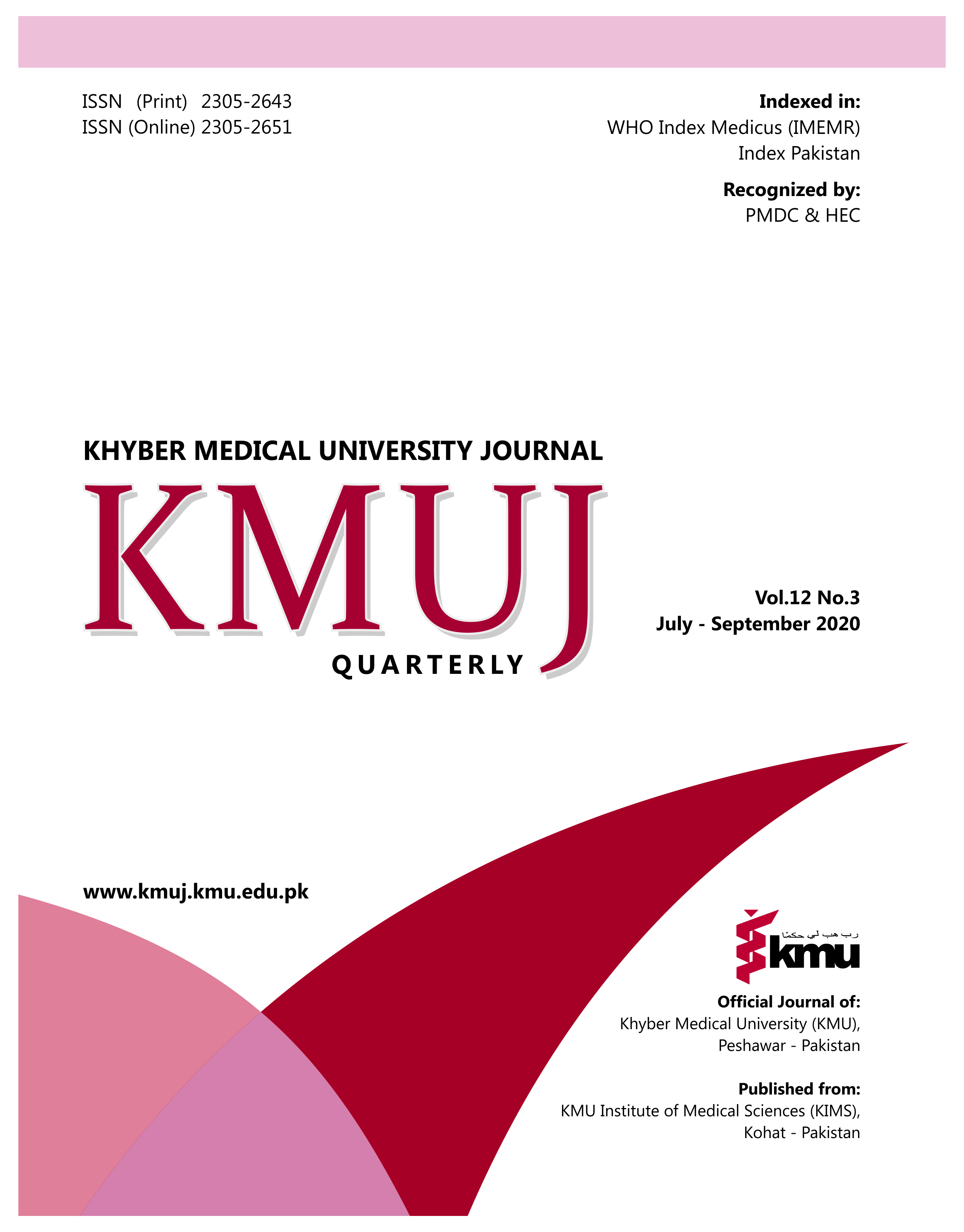SOCIO-ECONOMIC FACTORS FOR DEPRESSION IN WOMEN OF NORTHERN PAKISTAN: A CASE-CONTROL STUDY
Main Article Content
Abstract
OBJECTIVE: To find out the association between socio-economic factors with depression in women of Gilgit Baltistan (GB), Pakistan.
METHODS: This case-control study was conducted at various psychiatric facilities located in three districts of GB. Out of 450 participants, recruited through convenient sampling technique, 300 were depressed women according to DSM-5 criterion of depression, while 150 were well-matched controls from the same population. Logistic regression was applied to find out the association of socio-economic factors with depression.
RESULTS: Mean age of the participants was 36±11.2 years. About 40.7% (n=122/300) of cases and 16% (n=24/150) of controls were un-educated. Majority of cases (n=222/300: 74%) and controls (n=94/150; 62.7%) were married. About 66.7% (n=200/300) of cases and 48% (n=72/200) of controls were housewives. Odds of depression were 0.334 (95% CI: 0.132-0.848), 0.524 (95% CI: 0.186-1.475), 0.17 (95% CI: 0.045-0.637), & 0.38 (95% CI: 0.127-1.158) for women having primary, secondary, higher-secondary or graduation-level education respectively. Emotional abuse (odds=34.92, 95% CI: 6.281-194.190), lack of economic independence (freedom to spend) [odds=6.39; 95% CI: 1.535-26.630] and do not own land (odds=3.40; 95% CI: 1.126-10.307) were significantly associated with depression. Families with household income >20,000 Rupees/month (odds=0.22; 95% CI: 0.051-0.961) and cordial relationships with in-laws (odds=0.55; 95% CI: 0.241-1.262) were less likely to be depressed.
CONCLUSION: The study showed significant association of low level of education, emotional abuse, and lack freedom of spending with depression in women of northern Pakistan. The study underscores that socio-economic factors need to be considered in the management of depression among women.
Article Details
Work published in KMUJ is licensed under a
Creative Commons Attribution 4.0 License
Authors are permitted and encouraged to post their work online (e.g., in institutional repositories or on their website) prior to and during the submission process, as it can lead to productive exchanges, as well as earlier and greater citation of published work.
(e.g., in institutional repositories or on their website) prior to and during the submission process, as it can lead to productive exchanges, as well as earlier and greater citation of published work.
References
Murray CJL, Lopez AD (eds) World Health Organization (WHO), World Bank & Harvard School of Public Health. The Global burden of disease: a comprehensive assessment of mortality and disability from diseases, injuries, and risk factors in 1990 and projected to 2020: Summary. USA: Harvard Press;1996, pp. 2-18. [Accessed on: January 10, 2020]. Available from URL: https://apps.who.int/iris/handle/10665/41864.
Gausia K, Fisher C, Ali M, Oosthuizen J. Antenatal depression and suicidal ideation among rural Bangladeshi women: a community-based study. Arch Womens Ment Health 2009;12(5):351–8. DOI: 10.1007/s00737-009-0080-7.
Mumford DB, Nazir M, Baig IY. Stress and psychiatric disorder in the Hindu Kush: a community survey of mountain villages in Chitral, Pakistan. Br J Psychiatry 1996;168(3):299–307. DOI: 10.1192/bjp.168.3.299.
Charara R, Forouzanfar M, Naghavi M, Moradi-Lakeh M, Afshin A, Vos T, et al. The burden of mental disorders in the Eastern Mediterranean Region, 1990-2013. PLoS One 2017;12(1):e0169575. DOI: 10.1371/journal.pone.0169575.
Aliani R, Khuwaja B. Epidemiology of postpartum depression in Pakistan: A review of literature. Natl J Heal Sci 2017;2(1):24–30. DOI: 10.21089/njhs.21.0024.
Albert PR. Why is depression more prevalent in women? J Psychiatry Neurosci 2015;40(4):219-21. DOI: 10.1503/jpn.150205.
Niaz U. Women's mental health in Pakistan. World Psychiatry 2004;3(1):60-2.
Bano S, Asif AF, Saadat S, Muhammad N. Socioeconomic factors of depression among females visiting outpatient clinic in district Ghizar, Gilgit-Baltistan, Pakistan: A pilot study. Khyber Med Univ J 2018;10(1):23-6.
National Institute of Population Studies (NIPS) [Pakistan] and ICF. 2019. Pakistan Demographic and Health Survey 2017-18. Islamabad, Pakistan, and Rockville, Maryland, USA: NIPS and ICF. [Accessed on: January 10, 2020]. Available from URL: http://nips.org.pk/abstract_files/PDHS%202017-18%20-%20key%20%20findings.pdf
Bano S. Socio-Economic Factors of Depression Among Women in Selected Districts of Gilgit-Baltistan, Pakistan (Doctoral dissertation, University of Peshawar, Peshawar, Pakistan).
Harding TW, de Arango MV, Baltazar J, Climent CE, Ibrahim HH, Ladrido-Ignacio L, et al. Mental disorders in primary health care: a study of their frequency and diagnosis in four developing countries. Psychol Med 1980;10(2):231-41. DOI: 10.1017/s0033291700043993.
American Psychological Association. Diagnostic and statistical manual of mental disorders 5th ed. USA: American Psychological Association; 2000. [Accessed on: January 05, 2020]. Available from URL: https://www.psychiatry.org/psychiatrists/practice/dsm.
Nisar N, Billoo N, Gadit AA. Prevalence of depression and the associated risks factors among adult women in a fishing community. J Pak Med Assoc 2004;54(10):519-25.
Kessler RC, Foster C, Webster PS, House JS. The relationship between age and depressive symptoms in two national surveys. Psychol Aging 1992;7(1):119-26. DOI: 10.1037/0882-7974.7.1.119.
Patel V, Kleinman A. Poverty and common mental disorders in developing countries. Bull World Health Organ 2003;81(8):609–15.
Husain N, Creed F, Tomenson B. Depression and social stress in Pakistan. Psychol Med 2000;30(2):395–402. DOI: 10.1017/s0033291700001707.
Hussain A. Education system of Pakistan: Issues, problems and solutions. Islamabad Policy Res Institute 2015. [Accessed on: January 08, 2020]. Available from URL: https://ipripak.org/education-system-of-pakistan-issues-problems-and-solutions/.
Ayub M, Irfan M, Nasr T, Lutufullah M, Kingdon D, Naeem F. Psychiatric morbidity and domestic violence: a survey of married women in Lahore. Soc Psychiatry Psychiatr Epidemiol 2009;44(11):953-60. DOI: 10.1007/s00127-009-0016-6.
Domestic Violence and Depression - Breaking the Cycle; 2013. [Accessed on: January 08, 2020]. Available from URL: https://www.promisesbehavioralhealth.com/addiction-recovery-blog/domestic-violence-and-depression-breaking-the-cycle/
Ahmed Z, Nisa Q, Yousufzai AW, Khoja S, Chaudhry J. Trends and patterns of suicide in people of Chitral, Khyber Pakhtunkhwa, Pakistan. Khyber Med Univ J 2016;8(2):72-7
Du Rocher Schudlich TD, Papp LM, Cummings EM. Relations between spouses' depressive symptoms and marital conflict: a longitudinal investigation of the role of conflict resolution styles. J Fam Psychol 2011 Aug;25(4):531-40. DOI: 10.1037/a0024216.
Zainab S, Fatmi Z, Kazi A. Risk factors for depression among married women belonging to higher and lower socioeconomic status in Karachi, Pakistan. J Pak Med Assoc 2012;62(3):249–53.
Mirza I, Jenkins R. Risk factors, prevalence, and treatment of anxiety and depressive disorders in Pakistan: systematic review. Br Med J 2004;328(7443):794. DOI: 10.1136/bmj.328.7443.794.
